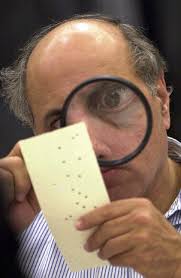dangling chads




kleroterion - used for jury selection

When a citizen sought jury duty, he went at dawn to the
kleroteria maintained by his tribe and showed up with other
potential jurors. He brought with him an identity ticket

made of
bronze or wood, and he gave it to the
presiding tribal officer
(known as the archon), who then slotted it into on of the kleroterion's
columns according to the jury-section letter stamped on the ticket.
The slots were filled starting at the top row and working down.
Once the candidate's tickets were slotted in, the archon took a quantity
of small bronze balls - some colored white, the rest black ... and poured
them into the funnels at the top of the kleroteria. The total number of balls
was equal to the number of rows filled with tickets, and the number of white
balls was a function of the number of juries that need to be filled that day.
So: the balls fell down into the tube, at the bottom of which they were
stopped by a crank-driven device. The crank was turned, and one ball dropped out.
If the ball was black, the first row of tickets was removed from the kleroterion,
and their owners were dismissed. If the ball was white, the first row of tickets
remained in place, and their owners were jurors for the day. Another ball was
released, another row of candidates dismissed or accepted, and so on. At last the
final ball was dropped and the judicial day began.

ostrakon - a piece of pottery usually broken off from a vase or other earthenware

vessel. In Ancient Greece, the voting public would write or scratch the name of a
person in the shard of potter. When the decision at hand was to banish or exile
a certain member of society, citizen peers would cast their vote by writing the name
of the person on the piece of pottery; the vote was counted and if unfavorable the person
was put out of the city....hence the term ostracism.
No comments:
Post a Comment